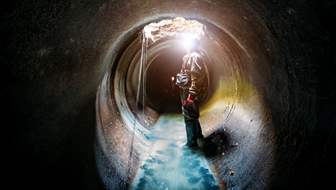Luke Wilson
Applications Engineering Intern at Inertial Labs.
What is LiDAR Point Cloud?
Components Overview
A LiDAR point cloud is a collection of millions (even billions) of points that is used to accurately map an environment in a way similarly to how a pointillism painting creates a picture. Each of these points have a location in a known coordinate system (local or global), along with a value for intensity which quantifies the amount of light energy that is recorded by the scanner. A LiDAR point cloud is the product of sensor fusion across a GPS-Aided Inertial Navigation System (INS) and a LiDAR scanner. Each sensor plays a critical role in how a LiDAR payload functions and the applicability of its point cloud output.
Read More
Topics:
LiDAR,
Point Cloud,
RESEPI
What is Spoofing?
Satellite constellations use RF signals to transmit information to GNSS receivers. These signals contain information on the satellite ephemeris, clock bias parameters, almanac, satellite health status and other information. Receivers use these signals to compute position (and timing) information in global coordinates of longitudinal and latitudinal location. Spoofers transmit signals with higher relative power (a dominating signal strength) than the GNSS/GPS signals that are typically received by receivers. These signals contain false positioning information which results in the receiver believing false data. This used to be a complicated and expensive process that only militaries could perform, but with technological advances and the growing pervasiveness of the internet, GPS spoofing transmitters can be found easily and inexpensively by members of the civilian population.
Read More
Topics:
INS-D,
GPS,
GNSS,
receiver,
NovAtel,
Spoofing
The Kernel-100
The Kernel-100 is a compact and lightweight Inertial Measurement Unit (IMU) and Digital Tilt Sensor (DTS) that consists of precision tri-axis MEMS accelerometers and tri-axis MEMS gyroscopes. This industrial grade IMU measures linear accelerations and angular rates with low noise and good repeatability. With continuous built-in test (BIT), electromagnetic interference protection, and flexible input power requirements, the Kernel-100 is easy to use in a wide range of higher order systems.
Read More
Topics:
Stabilization,
Surveying,
Industrial,
IMU,
Development,
Kernel,
Tactical
What is a Directional Survey?
A directional survey is a survey method that can be used to map a variety of underground drilling applications. Directional surveys are used to map a planned underground route by using aiding data provided from any combination of directional survey stations. [1] Directional survey stations serve as a reference point that corresponds to a measured depth along the actual bored path known as the actual well path. While the drill bores a hole along a planned route, data regarding the borehole inclination and azimuth is transmitted back to a computer that is controlled by an operator. This data allows the operator to control the speed and direction of the drill as it advances. Directional surveying enables the user to carry out operation with minimal disturbance to natural habitats and helps to reduce accidents that can occur from directional drilling, which is any drilling is not directly downwards.
Read More
Topics:
Surveying,
Industrial,
miniAHRS
Understanding The Magnetometer
Magnetometers measure the direction, strength, or relative change of a magnetic field at a particular location. (1) Though phonetically complex, magnetometers can be common devices used in everyday life such as compasses and metal detectors. In general, there are two basic types of survey magnetometers: vector and scalar magnetometers. Vector magnetometers measure magnitude and direction of a magnetic field. Alternatively, scalar magnetometers measure the absolute or vector magnetic field, using an internal calibration or known physical constants of the magnetic sensor.
Read More
Topics:
INS-P,
Magnetometer,
calibration





